The Liver Fluke – Cattle and Sheep
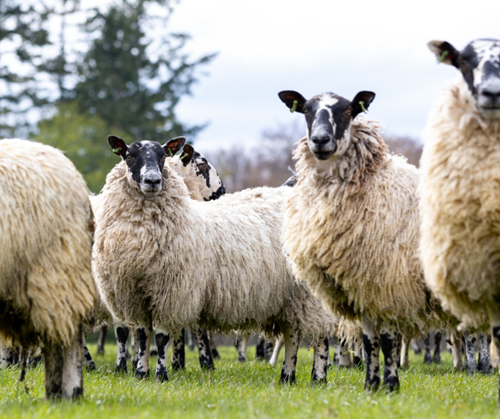
Although there has been limited summer, we are now, according to the met office, heading into autumn and the time has come to start thinking about testing for liver fluke and assessing the risk on your farm.
The liver fluke (Fasciola hepatica) is common to cattle, sheep as well as other wild mammals and even camelids. This means that control needs to be based on risk assessment across the whole farm. Liver fluke has been estimated to cost the UK sheep and cattle industries £95 million a year.
Some of the impacts/costs of liver fluke infection are:
Deaths
- Acute fluke infection in sheep.
- Chronic fluke infection in calves.
- Increased risk of Clostridial disease due to liver changes.
- Due to concurrent infections with other pathogens or nutritional issues exacerbated by reduced liver function.
Reduced productivity
- Increased barren rates or abortion.
- Poor young lamb viability due to reduced milk production.
- Decreased growth rates in lambs and calves leading to longer times to finish.
- Liver condemnations at the abattoirs.
- Costs of treatments and time to administer.
It is important to understand the lifecycle and the environmental factors that influence the time taken for the varying stages to complete, as this allows treatment to be done at the right time with an appropriate product.
Lifecycle – sheep, cattle and other mammals are final hosts with a mud snail acting as an intermediate host and being important for the life cycle to complete.
The mud snail as its name suggests like damp or wet areas of pasture.

The mud snail measuring about 2-3mm in size
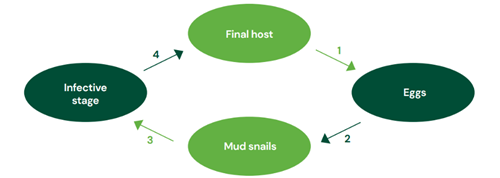
Video: Life cycle of the Liver Fluke: Fasciola hepatica (youtube.com)
- Mature flukes in the adult host lay up to 5000 eggs per day. These eggs develop into a mobile stage with a tail. This can take as a little as 10 – 14 days in optimal conditions (22°C) and won’t happen at all if the temperature is less than 10°C. However, the eggs can survive for several months and can over winter.
- The mobile stage needs to find a mud snail ideally within 3 hours but can survive up to 24 hours.
- Development within the snails takes a minimum of 6 weeks but can take months. The infective stages are then released by the snail and survive best in cool damp conditions. About half of those laid by the snails in September can survive the winter.
- Infective stage eaten by the final host, cross the gut wall and reach the liver where they tunnel through the liver tissue, eating it as they go for 6 – 8 weeks. Maturation to adults takes another 4 weeks.
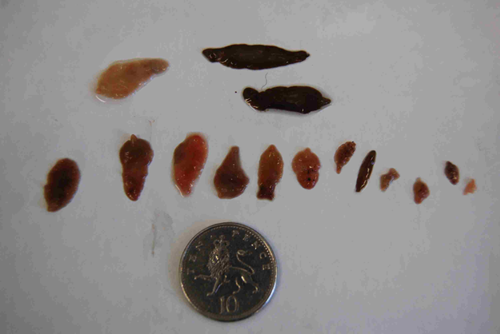
A range of different stages of fluke showing their sizes.
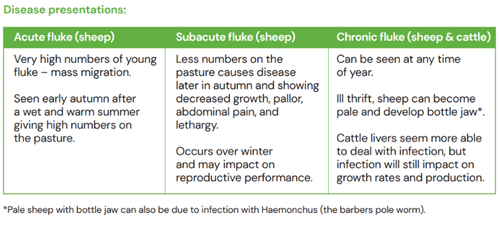

Pale eye

Bottle jaw
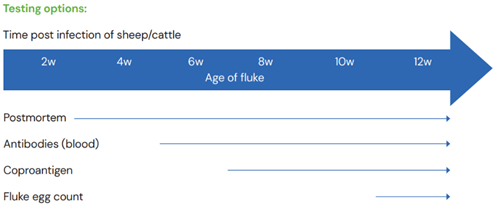
Antibodies in the blood do not give immunity to the animal but develop in response to infection and can be detected from about two to four weeks. These are useful in younger, first season grazing animals as sentinels. In older animals it is difficult to interpret as the levels can persist for up to year post infection.
Blood sample 10 first season grazing animals (lambs/suckler calves).
Coproantigen can be detected in the faeces from about six to eight weeks post infection. The test is looking for a substance that the fluke produces as it migrates through the liver.
Fluke egg count requires adult fluke need to laying eggs and therefore will not detect the fluke until at least 10 weeks post infection.
If submitting samples for pooled testing, it is better to submit the 10 (fresh) individual samples to your vet and they can be pooled at the practice or lab to allow increased consistency of results.
There is Preparing for Sustainable Farming funding available for a liver fluke investigation in both cattle and sheep which now can make use of all types of investigation. Find out more at Preparing for Sustainable Farming full guidance. All investigations must then have expert advice based on the results and an Expert Adviser Form completed.
Control
Prevention considerations
- Reduce snail habitats or access of animals to the wet areas where snails are more likely.
- Grazing strategies: Liver Fluke | Helping farmers in Scotland | Farm Advisory Service.
- Quarantine protocol: Cows guide to managing liver fluke in brought in cattle & Quarantine treatments.
Treatment
- Test before you treat and consider the weather and grazing history to ensure you are treating with the correct product at the correct time.
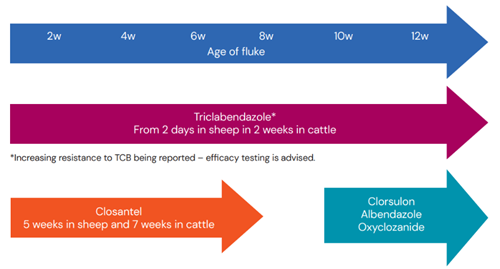
Top tips: Every farm and even individual fields have their own risk level.
Consider the risks to your specific situation, areas you may wish to assess include:
- Weather patterns.
- Grazing history - has the ground been wet, what animals have been where?
- Testing before treatment.
- Treat with appropriate product for the stock class and what age of fluke might be in the group.
Useful Links
- Fight the fluke
- What you need to know about liver fluke
- Liver fluke fact sheet
- Internal parasites and liver fluke
- Liver and rumen fluke
Kythe MacKenzie, Veterinary Investigation Officer, Kythe.MacKenzie@sruc.ac.uk

Unearthed is the exclusive SAC Consulting members' monthly newsletter. Unearthed offers insights and tips from our experts on what we think is in store for farming and crofting in the coming months in order to protect and enhance your business.
Posted by Unearthed News on 24/09/2024
